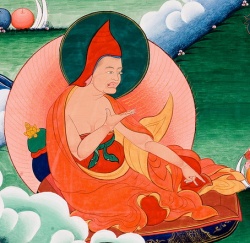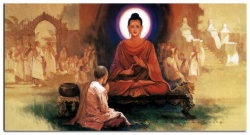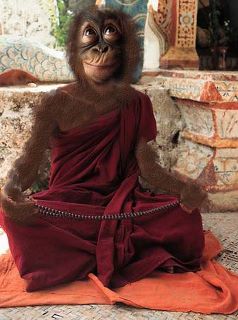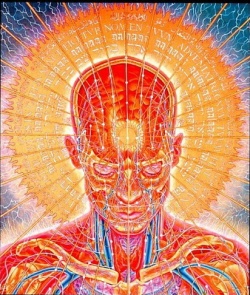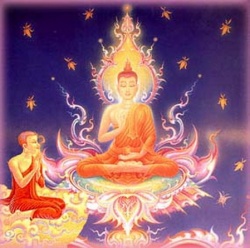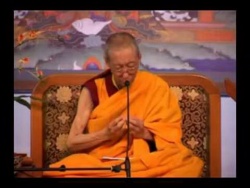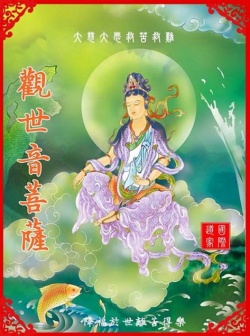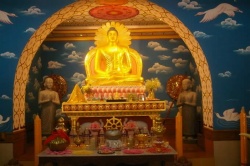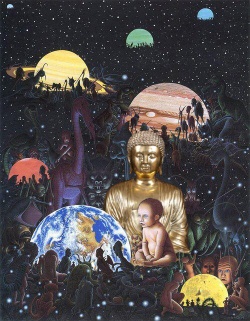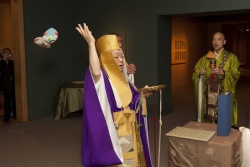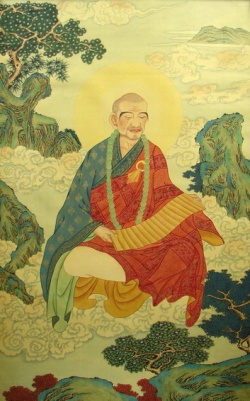Vasubandhu II
- Vasubandhu (Skt.; Tib. དབྱིག་གཉེན་, Yiknyen; Wyl. dbyig gnyen) numbers among the ‘Six Ornaments’, the greatest Buddhist authorities of Ancient India. He was the younger brother of Asanga, and composed The Treasury of Abhidharma (Skt. Abhidharmakosha), a complete and systematic account of the Abhidharma, the peak of scholarship in the Fundamental Vehicle. Later he followed the Mahayana Yogachara view, and wrote many works, such as Thirty Stanzas on the Mind (Trimsikavijñapti-karika).
Contents [hide]
1 His Writings
2 His Disciples
3 Further Reading
4 External Links
His Writings
Abhidharmakosha
Analysis of the Five Skandhas
Thirty Stanzas
Treatise on Karma
Treatise on the Three Natures
Twenty Stanzas
Well Explained Reasoning
His Disciples
He famously had four students who were more learned than himself: Sthiramati, who was more learned in Abhidharma; Dignāga, who was more learned in Pramāṇa; Guṇaprabha, who was more learned in the Vinaya; and Arya Vimuktasena, who was more learned in Prajñāpāramitā.
世親・天親 (n.d.) (Skt; Jpn Seshin or Tenjin)
He is known as the author of The Dharma Analysis Treasury. Vasubandhu was born to a Brahman family in Purushapura of Gandhara in northern India.
He had an older brother, Asanga.
In the central Indian city of Ayodhya, he studied the doctrine of the Sarvastivada school and lectured on The Great Commentary on the Abhidharma, the primary text of that school.
He compiled these lectures as The Dharma Analysis Treasury, which presents a comprehensive discussion of the Sarvastivada thought.
Thus he became the undisputed master of Hinayana philosophy in India at the time.
Vasubandhu at first criticized Mahayana, but later converted to it through the influence of his brother Asanga, whom he assisted thereafter in promoting the Yogachara, or Consciousness-Only, school of Mahayana.
Vasubandhu is said to have written a thousand works, five hundred related to Hinayana and five hundred to Mahayana.
Among those that have survived are The Twenty-Stanza Treatise on the Consciousness-Only Doctrine, The Treatise on the Ten Stages Sutra, The Treatise on the Lotus Sutra,
The Commentary on "The Summary of the Mahayana," and The Treatise on the Buddha Nature.
He is counted as the twentieth of Shakyamuni's twenty-three, or the twenty-first of his twenty-four, successors.
by Dan Lusthaus
- Vasubandhu, who lived around the Fourth century CE, was one of India's most prominent Buddhist philosophers.
His prolific writings record an odyssey through the systems of the leading Buddhist schools of his day.
Though primarily venerated by later Buddhists as co-founder of the Yogācāra school with his half-brother Asaṅga, his pre-Yogācāra works, such as the Abhidharma-kośa and his auto-commentary (-bhāṣya) on it, have continued to be seriously studied until the present day.
He wrote commentaries on many Mahāyāna texts, works on logic, devotional poetry, works on Abhidharma classifications (see below), as well as original and innovative philosophical treatises.
Many of his writings survive in their original Sanskrit form, but others, particularly his commentaries, are extant only in Chinese or Tibetan translations.
The Abhidharma-kośa
- Vasubandhu was born into a Hindu family at Puruṣapura (today called Peshawar) in the state of Gāndhāra in Northwestern India, best know today as one of the earliest regions to develop a distinctive form of Buddhist art noted for its blending of Indian and Western (Hellenistic) elements.
At Vasubandhu's time the dominant Buddhist school in Gāndhāra was the Vaibhāṣika (also called Sarvāstivāda) because its main text was the Mahā-Vibhāṣā, a huge Sarvāstivādin Abhidharma treatise spelling out their positions on Buddhist classificatory schema.
Vasubandhu studied this school and then traveled to the headquarters of the orthodox branch in Kashmir, studying with the leading teachers there.
After returning home, according to tradition, during the day he would lecture on Vaibhāṣika doctrine and in the evening distill the day's lectures into a verse.
When collected together the six-hundred-plus verses gave a thorough summary of the entire system; he entitled this work Abhidharma-kośa (Treasury of Abhidharma).
- The Kośa categorizes and analyses the basic factors of experience and reality, called dharmas, so as to map out the Buddhist Path to Awakening.
The Vaibhāṣika system, in Vasubandhu's version, had seventy-five dharmas divided into five major categories:
1. Eleven types of material form (the five sense organs and their corresponding objects, plus something called avijñapti which was considered to be a material counterpart to any intention that didn't disclose itself through verbal or bodily gestures);
3. Forty-six Mental Associates (attitudes, forms of attention, emotional states, etc., which accompany moments of cognition).
4. Fourteen conditions disassociated from mind (including linguistic, conceptual, meditational, and moral categories, e.g., grammatical entities, continuity and impermanence, attaining temporary cessation of mental activities [[[nirodha-samāpatti]]], accruing or divesting karma, etc.); and
5. Three Unconditioned dharmas:
[i] spatiality (ākāśa),
[ī] disjunction from impure dharmas by deliberate awareness,
[īi] non-arising of impure dharmas due to the absence of their productive conditions.
- While this scheme was primarily taken as a map of the path towards enlightenment, in its effort to comprehensively describe all the factors of reality the Kośa delved into the full range of Buddhist doctrine, including meditation practices, cosmology, theories of perception, causal theories, the causes and elimination of moral problems, the theory of rebirth, and the qualities of a Buddha.
The most important notion, subtending all other discussions in the Kośa, is karma.
Karma means 'action,' and in Buddhism denotes especially intentional actions with moral consequences (as distinguished from physical activity lacking any intention, that being called kṛiya rather than karma).
'Action' includes cognitive and linguistic acts as well as bodily movements.
In rudimentary terms karma theory states that present actions are influenced by previous actions and present actions will, in turn, influence future actions.
This influence is exerted from moment to moment as well as from life to life. Karmically, an action is either wholesome and beneficial (kuśala), unwholesome and disadvantageous (akuśala), or neutral.
For instance, a previous 'disadvantageous' action is such precisely because it eventually produces negative consequences, just as a current beneficial action is such because it will produce good consequences in the future, and so on.
The seventy-five dharmas are not only examined in terms of their definitions and interrelations, but most importantly in terms of their karmic qualities, i.e., how they affect and are affected by karmic processes. In that way the system becomes more than mere intricate scholarly analysis, it becomes a soteric vehicle.
- Apparently Vasubandhu began having second thoughts about Vaibhāṣika teachings, since he then wrote a prose commentary to the verses that refuted them, sometimes championing the objections of one of their key opponents, the Sautrāntikas.
One key point of dispute between Vaibhāṣikas and Sautrāntikas was whether dharmas exist in the past and future as well as the present (the Vaibhāṣika position) or whether they are discrete, particular moments only existing at the present moment in which they discharge causal efficacy (the Sautrāntika position).
The commentary attacked many other Vaibhāṣika notions as well.
The Abhidharmakośa-bhāṣya, as the verses with his autocommentary is called, outraged orthodox Vaibhāṣikas who wrote several treatises attempting to refute Vasubandhu's critiques.
Vasubandhu's interim writings
- Vasubandhu remained intellectually and spiritually restless, and continued to refine his abhidharmic thinking.
We do not know the precise order in which his remaining treatises were written (except that, according to tradition, the Trisvabhāva-nirdeśa, 'Elaboration of the Three Self-Natures,' was reputedly his last, and his Twenty verses and Thirty Verses came near the end -- but there is no actual evidence supporting that order).
However, the general trajectory of his developing ideas can be traced.
His Pañca-skandha prakaraṇa (Exposition on the Five Aggregates) discusses many of the topics covered in the Abhidharma-kośa, but instead of the kośa's seventy-five dharmas, several new ones have been added, and several of the original seventy-five have been dropped.
Moreover they are grouped into somewhat different categories.
The formulations and definitions of dharmas offered here are not yet the full list of 'one hundred dharmas' that Vasubandhu would write about later in a treatise of that name, but he is clearly moving in that direction.
- Vasubandhu's Karma-siddhi-prakaraṇa (Exposition Establishing Karma) challenged the views of the Vaibhāṣikas and any others who held that dharmas might be anything other than momentary. Momentariness (kṣanika-vāda) basically explained the series of consciousness moments as a casual sequence in which each moment caused its immediate successor.
Recognizing that the theory of momentariness had difficulty explaining certain types of continuity--from one life to the next, the re-emergence of a consciousness stream after it has been interrupted in deep sleep or meditation, etc.--near the end of the treatise he introduces the Yogācāra notion of the ālaya-vijñāna (storehouse-consciousness) in which the 'seeds' of previous experiences are stored subliminally and released into new experiences.
The metaphor of seeds (bījā) being planted in the consciousness stream by experiences, only to sprout later (break through from the subliminal into conscious experience), possibly producing new seeds that are implanted to be sprouted later, provided a handy agricultural model (easily understood by an agrarian culture) that for Vasubandhu not only explained continuity between two separate moments of consciousness, but also provided a quasi-causal explanation for the mechanics of karmic retribution, i.e., it described how an action done at one time could produce 'fruit' at another time, including across lifetimes.
The ālaya-vijñāna also eliminated the need for a theory of a substrative, permanent self that is the doer and recipient of karma, since, like a stream, the ālaya-vijñāna is perpetually changing with ever new conditions from moment to moment.
In this treatise Vasubandhu denies that something at time1 can be identical to what might appear to be the same thing at time, since, he claims, it is undergoing changes every moment, even if so small as to go unnoticed. In good Buddhist fashion Vasubandhu argues that reality consists of a stream of changing causes and conditions with no permanent entities (such as God, soul, etc.) anywhere.
- An early Buddhist logic text, called Vādavidhi, is attributed to him.
While from a modern perspective it fails to differentiate between debate techniques and logic per se, it does provide a glimpse of the state of Buddhist logic before the revolutionary developments that were introduced shortly thereafter by Dignāga and Dharmakīrti.
It also illustrates the importance of logically coherent thinking for Vasubandhu.
Conversion to Mahāyāna and the Thirty Verses
- According to tradition Vasubandhu's half-brother Asaṅga, after becoming discontent with the Mahīśāsaka Buddhist teachings he had been studying, went into the forest to meditate for twelve years, after which he felt no closer to his goal.
Then a Bodhisattva named Maitreya appeared to him from the Tuṣita Heaven (one of many Buddhist heavens, this one particularly important for Yogācāra), and instructed him, dictating a number of treatises to him (five, according to the Tibetan tradition) that became the foundation of the Yogācāra school.
In Mahāyāna Buddhism Maitreya functions as a type of messianic figure, the future Buddha who will come to earth when all sentient beings are sufficiently enlightened to enter Nirvana.
It should be pointed out that although Buddhists consider Vasubandhu and his brother to be the founders of Yogācāra, Yogācāric literature such as the Saṃdhinirmocana Sūtra had been in circulation for over a century before them.
Eventually Asaṅga 'converted' Vasubandhu to the Yogācāra viewpoint, and Vasubandhu began writing commentaries and treatises in earnest expounding his new views.
One, the Madhyānta Vibhāga (Discourse on the Middle Between Extremes) consists of verses by 'Maitreya' accompanied by Vasubandhu's commentary.
text attempts to refashion Nāgārjuna's notion of emptiness allowing it to reinforce rather than negate Yogācāric ideas.
- Vasubandhu's Triṃśikā (Thirty Verses), despite its brevity, is one of his most mature works.
In concise verses he sums up his doctrine of vijñapti-mātra (cognitive closure) by defining the eight consciousnesses theory of Yogācāra in abhidharmic terms, briefly explaining the Yogācāra three-nature theory, and concluding with a five step path to enlightenment.
The eight consciousnesses are the five sense consciousnesses (seeing, hearing, etc.); the empirical consciousness (mano-vijñāna); a self-concerned, self-aggrandizing mentality called manas; and the ālaya-vijñāna.
Vasubandhu describes each and explains how each can be overcome.
The point of vijñapti-mātra is not, as many writers have claimed, to establish a theory of Transcendental Idealism or to reify the mind as metaphysically real. On the contrary the stated goal of the Thirty Verses is the extinction of the eight consciousness through an 'overturning of their basis' (āśraya-paravṛtti).
Consciousness (vijñāna) -- which is 'closured' such that what appears to be a real, external world is nothing more than projected desires and predilections of consciousness-- is replaced by direct, immediate cognition (jñāna).
The five-step path gradually leads one to this enlightenment which is described elsewhere in Yogācāric writings as the transformation of the ālaya-vijñāna into the Great Mirror Cognition that, without preference, bias, anticipation or attachment, accurately reflects everything before it.
The Three-Nature theory
- The Three-Nature theory, which is treated in many Yogācāra texts including an independent treatise by Vasubandhu, maintains that there are three 'natures' or cognitive realms at play.
1. The delusional cognitively constructed realm, which is unreal and which posits hypostatic essences or 'selves' for oneself and others things.
2. The realm of causal dependency, which when mixed with the constructed realm leads one to mistake the products of the flux of causes and conditions for fixed, permanent entities.
3. The perfectional realm which functions like Nāgārjuna's 'emptiness' to remove all traces of hypostatic thinking and cognition.
It is an antidote (pratipakṣa) that 'purifies' or cleans the delusional constructions out of the causal realm, which when cleaned of all defilements is 'enlightened.'
These self natures are also called the Three Non-self-natures, since they lack fixed, independent, permanent identities and thus shouldn't be hypostatized.
The first is intrinsically unreal; the third intrinsically 'empty'; and the second (which finally is the only 'real' one) is of unfixed nature since it can be 'mixed' with either of the other two.
The Twenty Verses
- Vasubandhu's most original and philosophically interesting treatise is his Twenty Verses (Viṃśatikā).
In it he defends Yogācāra from objections by Realists.
Yogācāra claims that what we think are external objects are nothing more than mental projections.
This has been mistaken for an Idealist position because interpreters focus on the word 'object' instead of 'external.'
Vasubandhu does not deny that cognitive objects (viṣaya, ālambana, etc.) exist; what he denies is that they appear anywhere else than in the very act of consciousness which apprehends them.
He denies that such cognitive objects have external referents (bahya-artha).
What Vasubandhu means is that cognition never takes place anywhere except in consciousness.
Everything we know we have acquired through sensory experience (in Buddhism the mind is considered a special type of sense).
We are fooled by consciousness into believing that those things which we perceive and appropriate within consciousness are actually 'outside' our cognitive sphere.
Put another way, we mistake our interpretations of things for the things themselves.
Consciousness is driven by karmic intentionalities (the habitual tendencies produced by past actions), and how we perceive is shaped by that conditioning.
The goal of Yogācāra is to break out of this cognitive narcissism and finally wake up to things as they are, devoid of erroneous conceptual projections.
(1) space and
(2) time;
(3) subjective wishes don't determine objective realities; and
(4) the objective world functions by determinate causal principles.
Having stated the objection, Vasubandhu devotes the rest of the text to his response.
- Vasubandhu replies to the first two Realist objections by noting that objects also seem to have spatial and temporal qualities in dreams, although nothing 'external' is present. Thus the appearance of cognitive objects does not require an actual object external to the consciousness cognizing it;
but without the consciousness, nothing whatsoever is cognized. Consciousness, not an external object, is the necessary condition.
- For the third objection Vasubandhu argues that groups, due to collective karma, give rise to misperceptions or interpretations in common. According to karma theory, it is the consequences of one's own actions (karma) that determine what sort of situations one will be 'born into,' and thus the types of groups with which one will share common views and ways of seeing.
Thus, his general point is that how we see things is shaped by previous experience, and since experience is intersubjective, we congregate in groups that see things the way we do (based on similarities in our previous experiences).
In an intriguing example, Vasubandhu argues that the torturing guards in hell are not real beings but communal projections by hell denizens with which they torture themselves, since it is illogical that one would be born into hell unless one deserved it based on one's previous actions, and if so, then one would not be immune to hell's tortures--but the guards don't suffer, they mete out suffering.
The implication of his argument is that hell itself is merely a paranoid projection.
If one wished to make a similar point about intersubjective grouping of interpretations, one could use a common, if scatological example: the difference in the ways humans and flies respond to excrement.
Flies flock to it, while humans revile it as filthy and disgusting. Each views excrement according to the life condition, the sort of genetic programming and communal attitude collectively adhered to by its own species. Each takes its interpretation to accurately reference the intrinsic nature and qualities of the thing itself, rather than recognizing that the horizons of such interpretations are karmically conditioned.
- As for the fourth objection, Vasubandhu points out that the appearance of causal efficacy also occurs in dreams.
Moreover, in a wet dream, even though the erotic 'object' is not externally real, the imagined object causes an observable physical effect (with moral consequences), observable in the waking world as well in the dream.
Thus our conscious 'dreams' can have causal efficacy.
- After critiquing Indian atomist theories and explaining his seed theory (which, briefly put, is that because consciousness is intersubjective, there are two seed streams: the stream of one's own seed, and the streams of 'the seeds of others' that mutually influence each other), he returns to the analogy of dreams when addressing the question 'Can we know other minds?'
To the claim that other minds are unknowable or at least opaque, Vasubandhu replies that they are knowable, and no more opaque than our own minds are to ourselves.
Buddha, who is fully Awakened (=enlightened) knows others' minds more clearly than we know our own.
The reason objects and events seem less clear, less consistent in dreams than when awake is because during sleep the mind is overcome by sleepiness and, thus, not 'thinking clearly'; therefore, in a dream one does not know the objects therein are only dream-objects until one awakens.
To awaken (become enlightened) is to perceive clearly without any mental obstructions.
Not only can we know other minds, but we constantly influence each other for better and for worse. Thus karma is intersubjective.
Major Ideas
Whatever we are aware of, think about, experience, or conceptualize, occurs to us nowhere else than within consciousness.
External objects do not exist.
Karma is collective and consciousness is intersubjective.
All factors of experience (dharmas) can be catalogued and analyzed.
Buddhism is a method for purifying the stream of consciousness from 'contaminations' and 'defilements.'
Each individual has eight types of consciousness, but Enlightenment (or Awakening) requires overturning their basis, such that consciousness (vijñāna) is 'turned' into unmediated cognition (jñāna).
Bibliography
Abhidharma Kośa Bhāṣyam. translated into English by Leo Pruden from Louis de la Vall'ee Poussin's French translation from the Chinese. Berkeley: Asian Humanities Press, 1988-90, 4 vols. The only complete English translation of Vasubandhu's encyclopedic work. Includes an introductory essay, indices, and helpful notes.
Anacker, Stefan. Seven Works of Vasubandhu. Delhi: Motilal Banarsidass, 1984. One of the standard English works on Vasubandhu. Includes a biography that tries to harmonize various traditional accounts with known historical facts. Includes all the important Yogācārin and interim treatises. Each translation is accompanied by helpful essays and notes.
Lusthaus, Dan. Buddhist Phenomenology: A Philosophical Investigation of Yogācāra Buddhism and the Ch'eng wei-shih lun.. London: Curzon, 2000. Includes translations and discussion of Vasubandhu's Thirty Verses, and the Chinese translations by Paramārtha and Xuanzang, and well as an analysis of the philosophical context of Yogācāra thought.
Kochumuttom, Thomas. A Buddhist Doctrine of Experience: A New Translation and Interpretation of the Works of Vasubandhu the Yogācārin. Delhi: Motilal Banarsidass, 1982. The other standard work. Kochumuttom argues against the idealist interpretation of Vasubandhu, instead trying to show in his running commentary to the translations that Vasubandhu is a Critical Realist.
